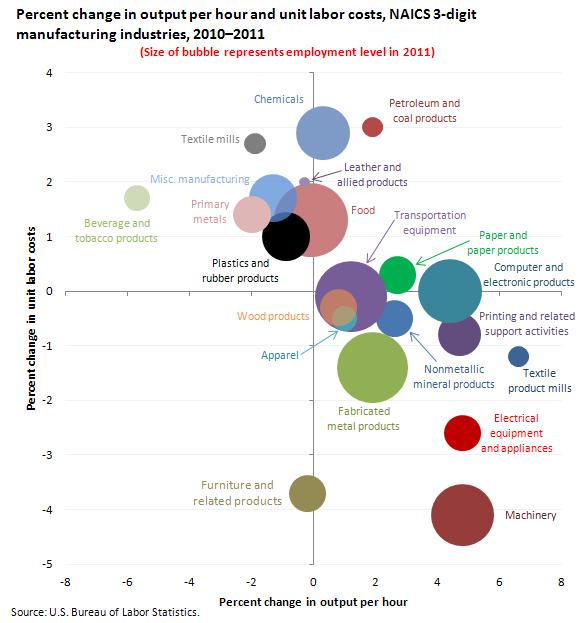An official website of the United States government
 United States Department of Labor
United States Department of Labor
Labor productivity—defined as output per hour—increased in 13 of 21 manufacturing industries in 2011. Output increased in 16 of these industries, and hours declined in 10. Unit labor costs fell in 10 of 21 manufacturing industries in 2011.

| 3-digit manufacturing industry | Output per hour(p) | Unit labor costs(p) | 2011 employment level |
|---|---|---|---|
Textile product mills | 6.6 | -1.2 | 125,100 |
Machinery | 4.8 | -4.1 | 1,068,900 |
Electrical equipment and appliances | 4.8 | -2.6 | 368,300 |
Printing and related support activities | 4.7 | -0.8 | 496,400 |
Computer and electronic products | 4.4 | 0.0 | 1,111,300 |
Paper and paper products | 2.7 | 0.3 | 388,300 |
Nonmetallic mineral products | 2.6 | -0.5 | 383,500 |
Petroleum and coal products | 1.9 | 3.0 | 112,600 |
Fabricated metal products | 1.9 | -1.4 | 1,373,200 |
Transportation equipment | 1.2 | -0.1 | 1,398,000 |
Apparel | 1.0 | -0.5 | 168,800 |
Wood products | 0.8 | -0.3 | 359,800 |
Chemicals | 0.3 | 2.9 | 790,500 |
Food | -0.1 | 1.3 | 1,493,400 |
Furniture and related products | -0.2 | -3.7 | 375,800 |
Leather and allied products | -0.3 | 2.0 | 30,100 |
Plastics and rubber products | -0.9 | 1.0 | 637,200 |
Miscellaneous manufacturing | -1.3 | 1.7 | 625,600 |
Textile mills | -1.9 | 2.7 | 129,100 |
Primary metals | -2.0 | 1.4 | 391,100 |
Beverage and tobacco products | -5.7 | 1.7 | 191,900 |
Footnotes: | |||
Among manufacturing industries in 2011, productivity rose fastest in textile product mills (6.6 percent), where output increased despite a drop in hours. Only 3 of the 21 industries registered greater productivity growth, or smaller productivity declines, than in the previous year.
In 2011, unit labor costs declined more frequently in manufacturing industries where productivity rose, as productivity gains offset increases in hourly compensation. Unit labor costs fell in 9 of the 13 industries where productivity rose.
These data are from the Labor Productivity and Costs program. The productivity measures reflect data classified according to the 2007 North American Industry Classification System (NAICS). The industry comparisons shown here are at the three-digit level of the six-digit NAICS coding structure. All of the measures for 2011 are preliminary and subject to revision. To learn more, see "Productivity and Costs by Industry: Manufacturing Industries, 2011" (HTML) (PDF), news release USDL‑13‑0478.
Bureau of Labor Statistics, U.S. Department of Labor, The Economics Daily, Labor productivity and unit labor costs among manufacturing industries, 2011 at https://www.bls.gov/opub/ted/2013/ted_20130328.htm (visited December 30, 2025).

